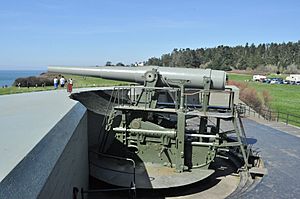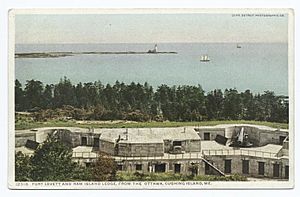Fort Foster (Kittery, Maine) facts for kids
Quick facts for kids Fort Foster Park |
|
|---|---|
| Kittery, York, Maine in United States | |

|
|
| Coordinates | 43°04′03″N 70°41′29″W / 43.06750°N 70.69139°W |
| Type | Fort |
| Area | 88 acres (36 ha) |
Fort Foster, now known as Fort Foster Park, is a historic fort located in Kittery, Maine. It was an active military site from 1901 to 1946. Today, the park offers beautiful beaches and walking trails for everyone to enjoy. The main parts of the old fort were Battery Bohlen and Battery Chapin.
Contents
History of Fort Foster
The United States government bought the land for Fort Foster in 1872. The fort itself was built between 1898 and 1901. This was part of a big project called the Endicott Program. This program aimed to build strong defenses along the U.S. coast.
Fort Foster was one of several forts protecting the harbor of Portsmouth. Other forts nearby included Fort Constitution and Fort Stark. Fort Foster was named after American Civil War hero, Brevet Major General John G. Foster.
Original Guns and Defenses
Fort Foster first had two main gun batteries. Battery Bohlen had three large 10-inch (254 mm) guns. These were "disappearing guns," meaning they could pop up to fire and then hide again. This made them harder for enemies to hit.
Battery Chapin had two smaller 3-inch (76 mm) guns. These guns were on special stands called pedestal mounts. Battery Bohlen was finished in 1901, and Battery Chapin in 1904.
Both batteries were named after Civil War generals who died in battle. Henry Bohlen and Edward Chapin were honored this way.
Protecting the Harbor
In 1909, a special station was added to control an underwater minefield. This minefield was placed in the harbor to stop enemy ships. Battery Chapin's main job was to protect this minefield. It would fire at any enemy ships trying to clear the mines.
Fort Foster During World War I
When the United States joined World War I in 1917, many coastal guns were moved. The military thought these guns might be needed on the battlefields in Europe. All three 10-inch guns from Battery Bohlen were taken away in October 1917. They were planned for use as "railway artillery," meaning they would be put on trains. However, they were returned to Fort Foster in September 1919.
Fort Foster During World War II
During World War II, even bigger guns were built at nearby Fort Dearborn. These new 16-inch (406 mm) guns made Fort Foster's older 10-inch guns less important. So, in 1942, the 10-inch guns at Battery Bohlen were removed and scrapped.
However, Fort Foster still played a role in the war. New buildings and defenses were added starting in 1940. A new station to control mines was built. Also, two new gun batteries were started.
Battery 205 was planned to have two 6-inch (152 mm) guns. These guns would have been protected by shields. A large six-story tower was also built to help spot targets for these guns. But the battery was never fully armed. Another battery, AMTB 952, was built in 1943. It had 90 mm guns to defend against fast enemy boats.
After the Wars
After World War II, the remaining batteries at Fort Foster were closed in 1946. The fort officially shut down in 1948. For a while, it was used as a fun spot for people working at the Portsmouth Naval Shipyard. Later, the land was given to the Town of Kittery. More land was added, creating the park we see today.
Fort Foster Park Today
Today, Fort Foster Park is a popular place for visitors. Most of the old military buildings are closed. However, the Mine Observation Tower has been turned into a public restroom.
You can visit the park for a small fee. It has lovely swimming beaches and offers great views. From the park, you can see the entrance to Portsmouth Harbor, Whaleback Light, Portsmouth Harbor Light, and Fort Constitution.
Gallery







